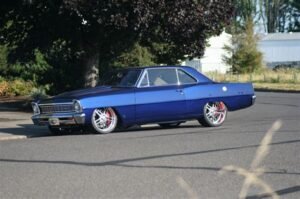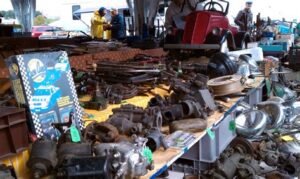
p>Classic cars hold a special place in our hearts: their timeless designs, their iconic features, and their general nostalgic appeal-all these evoke feelings of wonder and admiration. But time takes its toll on even the most cherished of vehicles, and bringing them back to their former glory often involves more than just a good wash and polish. Most of them are usually altered to make them further customized and really one-of-a-kind automotive treasures. The process of modification generally tends to be an affair of mixed emotions; at times, it is exhilarating, while at other moments, it could be cumbersome. The following guide will take readers on a tour of classic car modification with points and practical guides that you can use to give your favorite classic a new lease on life.
Engine Modifications: Power Unleashed
Inside every classic car, its heart-that is, its engine-is what gives it power and makes it so personable. Modifying the engine could be a very interesting process, as one could unlock its real potential and actually change the whole way of driving it. Moreover, engine modification can be a great thing to undertake, but lots of consideration is required, as indeed it calls for expertise, since this area significantly affects performance, fuel economy, and even the reliability of the car itself.
Improving Performance: A Harmonious Chime of Power
Performance-enhancing modifications on these engines generally take the form of engine displacements, airflow improvements, or efficiency in combustion. These enhancements can imply a significant addition to horsepower and torque, thereby increasing the intensity of the driving experience.
Increased Power:
Higher Displacement: Increased capacity from cylinder boring or a higher-capacity block raises the volume directly proportional to power output.
High-Flow Intake and Exhaust Systems: Performance headers, cold-air intake, and free-flowing exhaust systems could dramatically enhance airflow and enable the engine to breathe easy and give its full potential.
Performance Camshafts: Specialized camshafts optimize opening and closing valve timing for ensuring fuel and air enter the combustion chamber more efficiently and thus can give more power and torque.
High-Compression Pistons: Greater combustion efficiency equates to a more powerful and responsive engine.
Performance vs. Efficiency: Improving Fuel Economy
While some would never even question any performance enhancements on a classic car, there are those owners who want the most fuel efficiency possible. Indeed, through improvements in fuel economy, operational costs can be greatly lowered and environmental impact minimized.
Fuel Economy Enhancements:
Optimize Fuel Injection System: A state-of-the-art fuel injection system fitted in your classic car will provide precision in the delivery of fuel for complete combustion, hence saving on fuel consumption.
Lighter Wheels and Tires Installation: Unsprung weight reduction reduces the amount of energy needed to accelerate or decelerate; this surely results in improved fuel economy.
Optimization of Engine Tuning: Fine-tuning of air-fuel mixture entry into the engine provides increased combustion efficiency, thereby giving full utilization of the fuel supplied with minimal waste.
Synthetic Oils: The use of synthetic oils provides better lubrication owing to its low viscosity, which keeps friction to a minimum, and this ultimately brings in better engine efficiency.
Maintaining Reliability: A Balancing Act
While performance and efficiency upgrades may sound alluring, at the same time, reliability is a must. Improper engine modifications, if done, can make it a little less resilient.
Balancing Performance and Reliability:
Professional Consultancy: Certainly, the importance of consultations with a qualified mechanic, who has experience in classic car tuning, can’t be overestimated. They should outline everything to you step by step and make sure any adjustments are done properly and with safety in mind.
High-quality Aftermarket Parts: These are great for achieving long-lasting reliability in an engine. Low-priced parts reduce performance and lifespan.
Even with modifications, routine maintenance schedules remain essential for the purpose of keeping the engine running smooth without prematurely wearing out.
Suspension and Steering Modifications: Precise Handling
Classics came with suspension and steering that was designed in a very different era, mostly with little in terms of precision and control considered in today’s driving standards. Changes made to these components greatly improve handling and ride quality, not to mention the general driving experience.
Smoothing the Road: Improving Handling and Control
Updating the suspension and steering can dramatically increase the responsiveness and stability of a classic car, making it far more engaging and in control on the road.
Handling Modifications
Upgraded Shocks and Springs: Worn-out shocks replaced with high-performance units fitted with much-stiffer springs reduce body roll, improve cornering stability, and provide more control over the ride.
Coil-over suspension systems allow you to adjust both ride height and spring rates for that perfect balance in your driving style. For them, the sway bars will help a lot in reducing body roll in corners and generally improve the handling and responsiveness of the car. By doing so, you will add some more grip and thus create even better cornering stability and traction.
Smoother Ride Quality
While the improvements in handling are cardinal, ride comfort is equally important. Suspension modification can lead to better comfort without negation of performance.
Ride Quality Enhancements:
Adjustable Shock Settings: Most new-type shocks have their damping settings adjusted, by which you will be able to alter the stiffness of the suspension for balancing comfort and handling effectively.
Lower Profile Tires: Lower profile tires provide better handling and responsiveness but can sacrifice ride quality. You might want to look for a balance of the two that works for you.
Subframe Stiffeners: Adding stiffening braces to the car’s subframe will improve chassis rigidity-reduce vibrations, hence giving a smoother ride.
Polyurethane Bushings: Worn-out rubber bushings replaced with polyurethane ones will give better handling and reduce unwanted noise and vibration.
Modern Steering Enhancements: Precision Control
Classic car steering often lacks the responsiveness or fineness compared to modern vehicles. Such upgrades will make driving your car easier and more fun.
Steering Upgrades:
Power Steering: A power steering upgrade makes a great deal of difference in steering effort, with some installations making significant reductions in effort required to easily maneuver a car at low speeds.
Rack-and-Pinion Steering: It gives more direct feel to the steering while offering better responsiveness compared to traditional worm-and-sector steering.
Adjustable Steering Column: The adjusting steering column allows you to tailor the driving position to your comfort and exacting standards.
High-Performance Steering Wheel: A smaller diameter steering wheel with a grippy surface holds greater potential for improved handling and driver feedback.
Exterior and Interior Modifications: Enhancing Style and Comfort
Beyond performance and handling, classic car modifications also tend to extend to the exterior and interior, which are required to transform the look of the car for greater comfort and personalization for driver and passengers alike.
Exterior Modifications: Change in Looks
A number of classic car owners have their penchant for personalized touches for their car, with certain cosmetic touches believed to enhance this unique style and character considered hallmarks of classic vehicles.
Exterior Enhancements:
Custom paintworks: A fresh coat of paint, either in a bright color or with an intriguing design, will totally alter the appeal which the car has to completely reflect the great taste of the owner.
Wheel and Tire Upgrades: Larger wheels with more aggressive tires will enhance handling and give an added visual punch.
Lighting Upgrade: Smaller headlight and taillight upgrades will improve visibility and give a modern touch to the classic design.
Interior Modifications: Enhancing Comfort and Style
The interior of a classic car can be updated in a myriad of ways to enhance comfort, convenience, and overall aesthetic appeal.
Interior Improvements:
Reupholstering: Give the seats and door panels a rebirth with new upholstery materials inside for an instant luxury feel.
Modern Audio Systems: Installing a modern audio system with Bluetooth connectivity and advanced audio enhancement will make the driving experience quite higher than before.
Climate Control Upgrades: Outdated air conditioning systems are replaced with modern alternatives for better climate control and adding to the comfort during extremely hot or cold weather.
Custom Gauges and Dashboards: Upgrade the instrument cluster with modern gauges and a more ergonomic dashboard for better driver information and aesthetics.
The modification of a classic car is a journey for personal expression and love of the automobile. You get to take this timeless treasure into today’s times with new performance, handling, style, and comfort. With careful planning, expert guidance, and dedication to quality, you can reimagine your classic car as a work of art-a tribute to your love of automotive history and a reflection of your desire to create uniquely your own.




